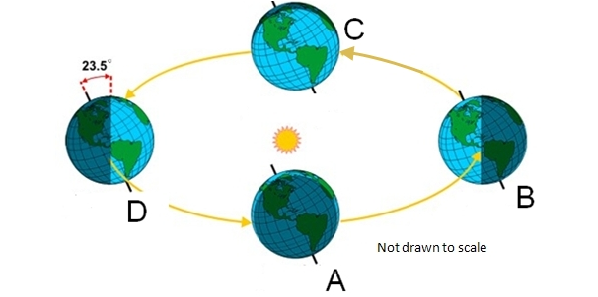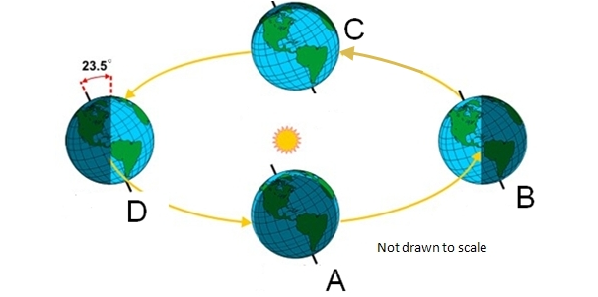Post Test For Sun-earth-moon System Quiz- Ngss Standards, 6th-8th Grade Resources, MS-ess1-1.

Post test to determine if basic information about the Sun-Earth-Moon system is understood.
This quiz will be used after the completion of a a lesson where students develop and model the
Sun-Earth-Moon system, MS-ESS1-1.
created by Karen Souza
- 1.
How many miles is the moon from the Earth?
- 2.
Did you notice any limitations to that last interactive model where you tried to figure out the relative size of the Earth, Sun, Moon, and Jupiter?If not, you can revisit it now to consider what is missing to help you figure out the last question with certainty. Type your answer into the box provided. What limitations exist?
- 3.
Phases of the Moon are caused by shadows from the Earth.
- A.
True
- B.
False
Correct Answer
B. FalseExplanation
Correct Answer is False: Our perspective of the Moon's sunlit appearance changes as it orbits Earth.
http://astro.unl.edu/classaction/animations/lunarcycles/lunarapplet.htmlRate this question:
-
- 4.
The Moon goes around the Earth in a single day.
- A.
True
- B.
False
Correct Answer
B. FalseExplanation
It takes about a month for the Moon to orbit Earth ( 27.3 days to complete a revolution, but 29.5 days to change from New Moon to New Moon.)
http://starchild.gsfc.nasa.gov/docs/StarChild/questions/question32.htmlRate this question:
-
- 5.
The moon is a source of light. It creates moonlight.
- A.
True
- B.
False
Correct Answer
B. FalseExplanation
Correct answer is False.
The Moon reflects the light of the Sun, just as the planets do. In fact, the bright part of the Moon is experiencing daytime.Rate this question:
-
- 6.
The Moon is only visible at night.
- A.
True
- B.
False
Correct Answer
B. FalseExplanation
Answer is False: We frequently see the Moon in the day; the only phases of the Moon that cannot be seen in the day are full moon (which is usually only visible at night) and the new moon (which is not visible from Earth at all),Rate this question:
-
- 7.
Which of the following four diagrams most accurately depicts the shape of Earth's orbit around the Sun?
- A.
A
- B.
B
- C.
C
- D.
D
Correct Answer
A. AExplanation
The correct answer is A. Earth's orbit around the Sun is nearly a perfect circle. Earth remains an average distance of 93 million miles (150 million kilometers) from the Sun throughout the year.Rate this question:
-
- 8.
Which of the following responses most closely explains why it is hotter in New York in June than it is in December?
- A.
The Sun gives off more heat energy in June.
- B.
Earth is closer to the Sun in June.
- C.
The Sun is higher in the sky and and provides more hours of daylight in June.
- D.
The Northern Hemisphere is closer to the Sun in June.
Correct Answer
C. The Sun is higher in the sky and and provides more hours of daylight in June.Explanation
The correct answer is D. The angle at which the Sun's light strikes Earth affects the temperature--the Sun's energy is more concentrated when the Sun is high in the sky. Weather is also warmer in summer because the Sun, being higher, provides more hours of light as it travels a greater distance across the sky. This longer exposure to sunlight gives the land, seas, and air masses more time to warm during the day.
When the Sun reaches high in the sky and its rays of light (and heat) strike the ground nearly perpendicular to the ground we have summer. When the Sun at noon is low in the sky, its rays hit the ground at a more glancing angle, resulting in the warming action of these rays being spread out more; any one spot receives less heat. We then have winter.Rate this question:
-
- 9.
Sometimes the Moon looks like thisAnd sometimes the Moon looks like thisWhat causes the Moon to change its appearance in this way?
- A.
As the Moon orbits Earth, Earth's shadow covers the Moon.
- B.
Clouds block part of the Moon from our view.
- C.
As the Moon orbits Earth, we see different views of the Moon's sunlit side.
Correct Answer
C. As the Moon orbits Earth, we see different views of the Moon's sunlit side.Explanation
The correct answer is C. The changing proportion of the Moon's sunlit side that we see as the Moon orbits Earth causes the phases of the Moon. In a given year, however, you can expect the Moon to encounter Earth's shadow a minimum of 2 times and a maximum of 5 times.Rate this question:
-
- 10.
Which of the following diagrams most closely depicts the distance between Earth and the Moon?
- A.
Diagram A
- B.
Diagram B
- C.
Diagram C
Correct Answer
A. Diagram AExplanation
The correct answer is A. Earth and the Moon are about 240,000 miles (roughly 387,000 kilometers) apart. In fact, 30 Earths laid end to end equal the distance between Earth and the Moon.
Even though it seems that the Moon is huge when it is on the horizon, this is an optical illusion. You can check this by comparing the size of the Moon at the horizon and overhead with the tip of your pinkie held at arm's length. The Moon will be the same size.Rate this question:
-
- 11.
The Earth spins, but the Moon does not.
- A.
True
- B.
False
Correct Answer
B. FalseExplanation
Both the Earth and the Moon spin. The Moon does spin on its axis, completing a rotation once every 27.3 days; the confusion is caused because it also takes the same period to orbit the Earth, so that it keeps the same side facing usRate this question:
-
- 12.
What causes the seasons?
- A.
The elliptical movement of the earth around the sun
- B.
The tilt of the earth at various stages of the earth's revolution around the sun
- C.
The solar wind moves the earth at different angles
Correct Answer
B. The tilt of the earth at various stages of the earth's revolution around the sunExplanation
The seasons are caused by the tilt of the Earth's rotational axis away or toward the sun as it travels through its year-long path around the sun. The Earth has a tilt of 23.5 degrees relative to the "ecliptic plane" (the imaginary surface formed by its almost-circular path around the sun)Rate this question:
-
- 13.
What is the rotation period of the earth?
- A.
365 days
- B.
24 hours
- C.
29 days
- D.
8 years
Correct Answer
B. 24 hoursExplanation
The earth takes 24 hrs. to make one full rotation.Rate this question:
-
- 14.
What is moon light?
- A.
Reflected light from the sun
- B.
The moon produces its own light
- C.
Electrical occurrence on the moon
- D.
The light from nearby planets
Correct Answer
A. Reflected light from the sunExplanation
The correct answer is A. The moon does not produce it's own light.Rate this question:
-
- 15.
When is it summer in the northern hemisphere?
- A.
A
- B.
B
- C.
C
- D.
D
Correct Answer
B. BExplanation
The answer is B. Due to the Earth's axial tilt, winter in the Northern Hemisphere lasts from the winter solstice typically December 21 to the March Equinox typically March 20 while summer lasts from the summer solstice typically June 21 through to the autumnal equinox typically September 23Rate this question:
-
- 16.
Which is the smallest? ___________________ You may use this interactive tool to help you. Use the scroll bar to determine the relative size and scale of each.To return to the quiz, press the x at the top of the pop up window to return to quiz.
- A.
A. Earth
- B.
B. Moon
- C.
C. Sun
- D.
D. Jupiter
Correct Answer
B. B. MoonExplanation
Correct Answer is B, the moon.Rate this question:
-
- 17.
When earth is between the moon and the sun there is a _____moon.
- A.
New
- B.
Full
- C.
Cresent
- D.
None of the above
Correct Answer
B. FullExplanation
Correct answer is B, full moon. At a full moon, the earth, moon, and sun are in approximate alignment, just as the new moon, but the moon is on the opposite side of the earth, so the entire sunlit part of the moon is facing us. The shadowed portion is entirely hidden from view.
http://www.moonconnection.com/moon_phases.phtmlRate this question:
-
- 18.
When the moon is between the earth and the sun there is a _____moon.
- A.
New
- B.
Full
- C.
Cresent
- D.
None of the above
Correct Answer
A. NewExplanation
The answer is A. As shown in the above diagram, the new moon occurs when the moon is positioned between the earth and sun. The three objects are in approximate alignment. The entire illuminated portion of the moon is on the back side of the moon, the half that we cannot see.Rate this question:
-
- 19.
The earth revolves around the__________
- A.
A. moon
- B.
B. sun
- C.
C. asteroid belt
Correct Answer
B. B. sunExplanation
Answer is B. Copernicus taught us the Heliocentric astronomical model in which the Earth and planets revolve around the Sun at the center of the Solar System.Rate this question:
-
Quiz Review Timeline +
Our quizzes are rigorously reviewed, monitored and continuously updated by our expert board to maintain accuracy, relevance, and timeliness.
-
Current Version
-
Mar 16, 2023Quiz Edited by
ProProfs Editorial Team -
Jan 07, 2016Quiz Created by
KarenSN
 Back to top
Back to top

















